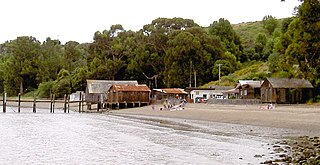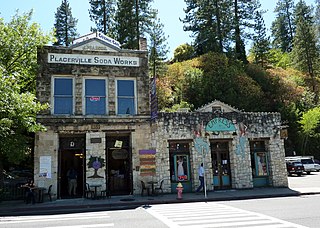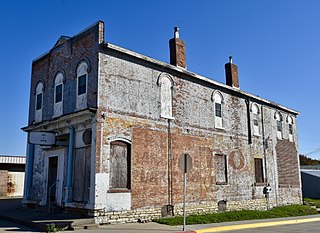
China Camp State Park is a state park in Marin County, California, surrounding a historic Chinese American shrimp-fishing village and a salt marsh. The park is located in San Rafael, California, on the shore of San Pablo Bay. It is known for its hiking and mountain biking trails, scenic views, and open spaces. The 1,514-acre (613 ha) park was established in 1976. A 75-acre (30 ha) district, including the shrimping village and a prehistoric shell midden, were added to the National Register of Historic Places in 1979 for having state-level significance in archaeology, architecture, commerce, settlement, and social history. China Camp State Park, along with the Rush Ranch Open Space Preserve, is part of the San Francisco Bay National Estuarine Research Reserve.

The Angels Hotel in Angels Camp, California, was the hotel where the author Mark Twain heard a story that he would later turn into his short story "The Celebrated Jumping Frog of Calaveras County".

Fort Yuma was a fort in California located in Imperial County, across the Colorado River from Yuma, Arizona. It was on the Butterfield Overland Mail route from 1858 until 1861 and was abandoned May 16, 1883, and transferred to the Department of the Interior. The Fort Yuma Indian School and the Saint Thomas Yuma Indian Mission now occupy the site. It is one of the "associated sites" listed as Yuma Crossing and Associated Sites on the National Register of Historic Places in the Yuma Crossing National Heritage Area. In addition, it is registered as California Historical Landmark #806.
Shasta is a census-designated place (CDP) in Shasta County, California, United States. Shasta sits at an elevation of 843 feet (257 m). Its population is 1,043 as of the 2020 census, down from 1,771 from the 2010 census.

The Howes Building is a historic building located in Clinton, Iowa, United States. The four-story, brick, Neoclassical structure features arched windows, pilasters, and a chamfered corner. At one time it had a prominent entrance on the corner that was flanked by columns in the Doric order. The columns remain in place even though the entrance has been modified. The architect for the first three stories, finished in 1900, was Josiah Rice. The fourth story, finished five years later, was designed by John Morrell. Both were local architects, Morrell having purchased the Rice firm in 1903. The contractor was John Lake. Edward M. Howes had the building constructed during a period of population and economic growth in Clinton. The two upper floors have housed the offices of local professionals. The first and second floors have housed various retail establishments, including Kline's Department Store, Stage Department Store, Jefferson Billiards Shop, Metzger and Cavanaugh Men's Tailors, and the Kaybee Store. The building has been listed in the National Register of Historic Places since 2004.

The T.G. Richards and Company Store, also known as Whatcom County Courthouse and James B. Steadman Post No. 24, is the first and oldest brick building in the state of Washington, United States, and is listed on the U.S. National Register of Historic Places.

Horton Grand Hotel is a restoration of two historic hotels, the Grand Horton and the Brooklyn Kahle Saddlery, in downtown San Diego, California. The Horton-Grand was added to the National Register of Historic Places in 1980.

Known informally as the Octagon Building, the redbrick octagonal building at 118 Cooper Street in Santa Cruz, California was built in 1882, adjacent to the first (1866) County Court House, to serve as the County Hall of Records. In 1894, a major fire destroyed most of the nearby buildings, including the adjacent courthouse, but the brick Octagon survived.

Mount Saint Mary's Convent and Academy, originally the Sacred Heart Convent and Holy Angels Orphanage and previously Mount St. Mary's Convent and Orphan Asylum, and also known as Mount Saint Mary's Academy and Convent, is the only extant original orphanage in California and commemorates the Sisters of Mercy, in Grass Valley, Nevada County, California.

Feraud General Merchandise Store, also known as 1903 Building, was built in 1903 in Ventura, California. Jules Feraud opened the Feraud Bakery and Grocery Store and the bakery stayed in the family until 1944. The brick building is a rare intact example of turn-of-the-century commercial architecture during Second Land Boom after the tracks of the Southern Pacific Railroad arrived in Ventura. The City Council of Ventura designated the building Historic Landmark Number 35 by resolution on July 17, 1978. The building was listed on the National Register of Historic Places in 1986.

The John Pearson Soda Works, also referred to as the Placerville Soda Works, is a historic rustic vernacular Victorian brick building in Placerville, El Dorado County, California. The building, in the Gold Country region, was placed on the National Register of Historic Places (NRHP) on December 12, 1985. The building currently houses the Cozmic Café coffee shop.
Brick Store may refer to any of the following, all of which are on the National Register of Historic Places (NRHP):
Helena is a ghost town in unincorporated Trinity County, California, United States. It is located on the North Fork of the Trinity River, 10 miles (16 km) west-northwest of Weaverville. State Route 299 runs right past the former town to the south; East Fork Road connects the highway to Helena.

The A. Berding Home is a historic Carpenter Gothic Victorian style house built by pioneer merchant Arnold Berding in 1875 at 455 Ocean Avenue in Ferndale, Humboldt County, California is also called "The Gum Drop Tree House" from the neatly trimmed row of cypresses in front.

The Hines Mansion is a historic house in Provo, Utah, United States. It is listed on the National Register of Historic Places. It was built in 1895 for R. Spencer Hines and his wife Kitty. At the time the mansion was built, it was recognized as one of the finest homes in Provo. The Hines Mansion was designated to the Provo City Historic Landmarks Registry on March 7, 1996.

The Smith and Weller Building, also known as the Knights of Pythias Hall, was a historic building located in New London, Iowa, United States. Charles W. Smith and C.B. Weller bought the lot on which the building sat for $300 in 1872. The building itself was built sometime before 1879 when Smith and Weller sold the lot to Sam Keiser and W.S. Workman for $2,500. The structure was designed in the Italianate style and featured simple brick-patterned arches. Keiser and his wife owned the building until 1907 when they sold it to the Knights of Pythias for their lodge. A hardware store occupied the main floor and the lodge was on the second floor. The Knights of Pythias sold the building in 1946 to Otis and Mae Maginnis. The building housed a bar in the intervening years. It was listed on the National Register of Historic Places in 2003, and it was delisted in 2020. The building was demolished in 2020.

The Swedesburg Historic Commercial District, also known as the Swedish Heritage Museum, is a nationally recognized historic district in Swedesburg, Iowa, United States. It was listed on the National Register of Historic Places in 1999. At the time of its nomination it consisted of four resources, which included three contributing buildings and one non-contributing building.

Rankin's was a department store at 117 W. Fourth Street at Sycamore in downtown Santa Ana, California. The Rankin Building is listed on the National Register of Historic Places on its own and also as a contributing property of the Downtown Santa Ana Historic Districts.

The Col. John Q. and Rowena (Camp) Wilds House, also known as the James and Ruth (King) Smith House, is a historic building located in Mount Vernon, Iowa, United States. It is significant with the settlement of the city that was influenced by the establishment of the Military Road, for being constructed of locally made brick and locally quarried limestone, and its vernacular architectural techniques. A native of Fulton County, Pennsylvania, John Wilds settled in Mount Vernon in 1853, opened a general store, and invested in real estate. He married Rowena Camp and they had two daughters. Wilds had this house built in 1857. It was probably built by brothers Henry and William Albright, the town's earliest masons. The two-story, brick structure exhibits elements of Early Republic influences. John Wilds grew wealthy and bought a gristmill. He sold the mill in 1860 and with the outbreak of the American Civil War he volunteered for the 13th Iowa Infantry Regiment. He rose to the rank of Colonel. He was wounded at the Battle of Cedar Creek and died a week later. His wife and two daughters died of illnesses around the same time. The house was listed on the National Register of Historic Places in 2020.


















